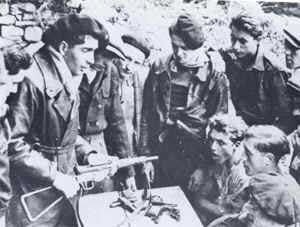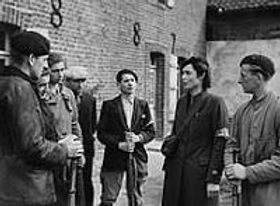La Resistance
When France surrendered to Germany on 22 Jun 1940, those who resented Germany occupation and the Vichy government formed cells that collectively were named the French Resistance. Some groups were violent in nature, aiming to hurt or kill the German occupiers; these were called maquis. Other groups used non-violent means, publishing underground newspapers and broadcasted anti-German and anti-Vichy radio programs. Many of these groups were born after the 18 Jun 1940 address by Charles de Gaulle who encouraged the French people to continue the fight against the German forces even if the nation surrendered. To take advantage of these groups, the British Special Operations Executive (SOE) began infiltrating into France beginning in May 1941 to aid the resistance groups. Because de Gaulle often disagreed with his British allies, he formed his own agency to independently aid French resistance efforts without coordinating with British efforts. In the beginning, the resistance groups were scattered and lacked cooperation. On 22 Jun 1941, all communist groups in France merged into a larger group, showing the rest of the resistance groups the effectiveness of more coordinated resistance actions. On 11 Nov 1942, German forces marched to Vichy-held southern France, and the resistance sentiment spread into that region as well, especially after the Vichy government adopted some German-influenced anti-Semitic policies.



The initial German response was that of annoyance, and it soon turned into great frustration. "During the summer of 1941 the civilian population's resistance to our occupation forces intensified perceptibly in every theater of war, with sabotage incidents and attacks on Germany security troops and installations", German Field Marshal Wilhelm Keitel recalled the reports that came to his desk during the war. "[A]cts of sabotage became horrifying frequent in France and even in Belgium." The counter the resistance movement, German forces employed a policy to rule by iron fist, including later retribution operations against innocent civilians. The SS also tortured many suspected resistance group members, with them ending up either dead or in a concentration camp. Rarely, entire villages would be razed as deterrence to future acts of sabotage; such was the fate of the village of Oradour-sur-Glane. Adolf Hitler insisted that such draconian measures were necessary to deter the would-be "terrorists", otherwise the situation in France would become out of control. Despite the risks, many fighters continued to wield British-supplied weapons to fight.
In 1943, when the prospect of a cross-Channel invasion on France became closer to reality, the United States also began aiding the French Resistance. The Office of Strategic Services (OSS) began sending its own agents into France in cooperation with the SOE to rally French support against German occupation.
On 27 May 1943, after months of work, Jean Moulin persuaded several resistance groups to merge into the Conseil National de la Resistance (CNR), with Moulin becoming the first chairman of the alliance. On 21 Jun, however, Moulin was captured by the German Gestapo and was tortured to death. Henri Giraud and Charles de Gaulle became joint presidents of the CNR after the death of Moulin, but by Oct that year, the politically-minded de Gaulle maneuvered Giraud out of the position of power and became the sole leader of CNR. Although de Gaulle was difficult to work with for the Allied commanders, with him in London, it was possible for the Allied command to pass orders for the resistance fighters to attack key communications and transportation targets to aid the planned Operation Overlord. 93 small teams of three agents (one American, one British, and one French) were then sent into France to closely coordinate actions immediately before the invasion. The resistance fighters continued to aid Allied invasion efforts after the forces had made footing on continental Europe, in northern France aiding the troops marching toward Paris, and in southern France during Operation Dragoon.
Groups in Paris, supported by the Paris policemen, began their fiercest resistance on 19 Aug 1944, attacking German forces with rifles and grenades while rounding up collaborators for execution. The fighting climaxed on 22 Aug. 1,500 resistance fighters and civilians lost their lives before Paris was liberated on 25 Aug. Three days later, de Gaulle called for the disbanding of all resistance groups and encouraged them to join the new French Army under his direct control.
The French Resistance Timeline
21 Aug 1941 A German naval cadet became the first victim of French Resistance, shot in a Metro station in Paris, France. Over 150 Parisians were shot in reprisal.
24 Aug 1941 Vichy France passed anti-terrorist laws, punishable with death sentences, to deal with the resistance movement.
15 Sep 1941 German soldiers were attacked by resistance fighters in Paris, France.
1 Jan 1942 Jean Moulin, the former mayor of Chartes, parachuted into France in an effort to coordinate and unify resistance groups.
15 Apr 1942 German headquarters at Arras, France was attacked by members of the French Resistance.
31 Jan 1943 The Milice was created in Vichy France under Joseph Darnand to counter the Resistance. This organization became another force of the German occupation, reaching a strength of over 20,000 by the Allied invasion in 1944.
27 May 1943 The first unified meeting of French resistance groups took place, chaired by Jean Moulin; it recognized de Gaulle as the leader of the movement. Moulin would be betrayed to the Gestapo a month later, dying en route to a concentration camp.
29 May 1943 Berthe Albrecht was captured by German agents in Mâcon, France.
31 May 1943 Berthe Albrecht was executed by hanging at the Fresnes Prison in Fresnes, France.
3 Jun 1943 French Resistance saboteurs destroyed 300 tons of tires in the Michelin factory at Clermont-Ferrant.
19 Dec 1943 French Résistants engaged in heavy fighting with Germans in Bernex, France.
19 Jan 1944 Resistance fighters blew up the Usines Ratier airscrew works, in southwetern France, wrecking it so thoroughly that it never resumed production in wartime. The charges with 30-minute fuses, laid while German guards patrolled the yards outside, detonated with such force that one 30-ton press was sent 25ft into the air.
1 May 1944 British Squadron Leader Maurice Southgate, whose task it was to coordinate the various Marquis
groups between the Loire River and the Pyrenees mountains, was arrested by the Gestapo in Paris, France.
10 May 1944 The French Resistance claimed a membership of over 100,000 and requested more military aid from the Allies.
28 Jun 1944 French resistance fighters killed Minister of Information and local Milice leader Phillipe Henriot. Milice leader in Lyon, Paul Touvier, was ordered to conduct reprisal killings.
30 Jun 1944 Milice leader in the French city of Lyon, Paul Touvier, selected 7 Jewish prisoners to be executed by firing squad as a reprisal for the killing of Minister of Information and local Milice leader Phillipe Henriot two days earlier by the French resistance.
19 Jul 1944 From Britain, US 8th Air Force dispatched 5 B-17 bombers to drop propaganda leaflets in France and Belgium while 5 B-24 bombers paradropped supplies to French resistance fighters.
20 Jul 1944 6 US B-17 bombers were launched after sundown to drop propaganda leaflets over France while 12 B-24 bombers dropped supplies to resistance fighters.
16 Aug 1944 French resistance fighters captured three German posts along the Swiss border.
20 Aug 1944 French resistance fighters liberated Toulouse, France.